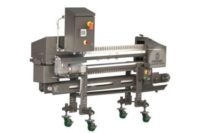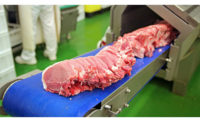DELI PROCESSING
A Clean Cut
By Tom Wray, Associate Editor
Deli-meat processing has some unique challenges in guaranteeing food safety.
Deli meats are used every day on countless sandwiches across the country. They’re a staple of the American diet. And making sure the products are safe to eat is a priority for the nation’s deli processors.
Most meat processors often devote most of their focus on pathogens such as E. coli O1:H57 and similar bacteria. Deli meats, on the other hand, are considered “ready-to-eat” products, where E. coli has already been killed by cooking.
“The uniqueness is combating Listeria; the challenge all of us face is that we’re dealing with a pathogen, you can’t see, taste or smell,” says Mark Shuket, president of Albany, N.Y.-based Old World Provisions. “And it takes two to three days to get the results back of any testing.”
Shuket, who also serves as president of the North American Meat Processors Association (NAMP), goes on to say that controlling the environment is the most important part of controlling contamination, no matter what the pathogen. His company uses anti-microbial foamers at every entrance to the plant to eliminate anything tracked in on people’s feet. Garments worn on the line are kept separate from other garments and from the outside world. Ozone and ultraviolet light is also used in small doses to stop any airborne pathogens.
Janelle Plantz, marketing manager of West Liberty foods LLC, West Liberty, Iowa, says their company is also focused on cross-contamination. “In any slicing operation, the biggest concern is preventing cross-contamination when taking a sterile log of meat, stripping off the casing and running it through a slicer and getting it into a sterile package,” she says.
After spending a lot of time researching, West Liberty has built two state-of-the-art slicing facilities with clean-room designs, pharmaceutical-grade protective clothing, separate slicing cells, closed-air systems and extensive employee training programs.
Plantz says an effective sanitation program, individual slicing cells, separate air and drain systems, and sanitary clothing designed to ensure minimum contact with the product are just a few of the things that the company has discovered as ways to minimize risk.
“Each of these items has [its] own unique concern,” she says. “Raw materials are known to contain different types of bacteria, and the key is to prevent growth, handling it properly, observing age limits.”
Processing concerns, Plantz continues, include foreign object control, utilizing sanitary equipment design, proper cooking to ensure a full lethality of these pathogens, proper cooling to ensure no growth of spore forming pathogens and good manufacturing practices during handling after the lethality step so none of the bacteria is re-introduced.
Industry specific
“As opposed to E. coli, raw materials don’t come into play,” Shuket says. “It’s the environment. The product is cooked to the point where the bacteria is killed. They have to look upstream and downstream, from feedlots to consumer, to control contamination.” A plant wants the freshest meat possible, but the cooking means that Listeria is a bigger concern than E. coli.
Shuket believes Old World Provisions is ahead of the curve in dealing with hygiene. The biggest challenge, he adds, is making sure that the people on the line and in the facility keep the protocols going.
“We could do everything right, and if one person makes a mistake. it can cause the problem,” says Shuket. “That’s the only thing that’s not totally under our control, because you can’t watch every minute of the day. But we do very good with it.”
Shuket says that smaller companies may have to struggle to keep up the same kind of supervision on the floor.
An overarching concern for Shuket, especially as NAMP president, is ensuring that all processors understand how testing and attention is increasing on the process as a whole and especially at the processing level.
One change that has already started to affect the industry is the U.S. Department of Agriculture’s (USDA) increasing use of DNA in pathogen testing. The method is already used in testing for E. coli. One problem that has appeared is samples are testing as positive when the test is used, but the test is finding dead, and thus harmless, bacteria. Shuket also says that food-safety audits will be increasing throughout the industry at all levels, as is already happening with E. coli. “They’re going to be doing intense verification on product samples,” he says. “If people are not ready for this, they’re going to have a lot of problems in the industry.”
Industry resources
Thanks to the company’s membership in NAMP, Old World Provisions has learned ways to help prevent contamination and some facts about hygiene. Shuket recommends using resources such as association membership as a way to keep current on issues and solutions to food safety. One fact is, the cleaner the plant, the easier it is to find Listeria.
Shuket explains that as areas are cleaned, all bacteria is eliminated, including bacteria that can hold other microorganisms in check. After a thorough cleaning, there’s nothing to hold Listeria back if any is left behind. This creates another challenge for processors.
Along with hygiene, which Shuket says should be standard to begin with, the company also uses a Listeria inhibitor in its products. It prevents the pathogen from getting any hold in the final product. “Everyone should be using an inhibitor,” he says.
If a company does test positive, Shuket adds, the USDA will realize through its inspections that a processor is doing everything right and is willing to work with the company to help it solve the problem.
“Food safety is our number one goal,” he says. “For everybody, from the processor to the USDA.”
Shuket believes that to truly control Listeria, the industry may have to make the use of inhibitors mandatory. And not just at the processor level. With meat displayed open-faced in cases, for example, more protection could be beneficial.
Maintaining safety
“It is a process that never ends and is constantly changing due to continuous education, extensive training and monitoring practices,” says West Liberty’s Plantz. “It is imperative to keep a close eye on new technology in product development, equipment design, chemical interventions, rapid detection and testing methods that can help to raise the bar in all facets in production.”
Shuket says that testing of the environment is essential. Test the procedures and the environment. And if the product is tested, it must be held until the results are returned.
“We should always be careful with sanitation and hygiene,” he continues. “Everybody has to be diligent. It doesn’t matter what you use, unless you’re taking care of theenvironment.”
Food-safety scares that have gained so much attention in recent months have had an effect on how people in all parts of the processing pipeline approach the issue. Consumers need to take part in food safety themselves.
“The consumer is really not informed the way they should be,” Shuket says. “On the consumer side, they’ve got to be more educated about taking care of their end of it.”
Processors have gotten the worst of the bad publicity, but consumers simply don’t know better, says Shuket.
“The whole process will be getting attention, from the feedlots and ranches through the processors on down to the retail level and the consumer’s own food-safety practices,” he says. In fact, New York state recently passed a law requiring more food safety inspections of restaurants. Shuket concludes that effective food-safety will need to go up and down the entire food chain.
“It can’t be just the food processors, has to be everybody,” he says. “Until that is accomplished, it has to be addressed at the processor level.”



Report Abusive Comment